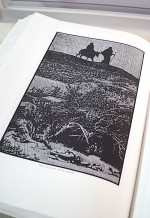Column Name
Title
Generous Gifts Enhance Library Collection
Juilliard has received yet another extraordinary gift from Board Chair Bruce Kovner and his wife, Suzie: a magnificent limited edition of the two-volume Pennyroyal Caxton Bible, which was published in 1999 and was the first edition of the Old and New Testament since 1865 to be illustrated by one artist (Barry Moser).
Body
Lavishly illustrated bibles have always held an important place in religious history, as well as in the history of book arts. Copies of Gutenberg’s historic bible, the first book printed entirely from moveable type, in the 1450s, included hand-drawn illustrations and illuminated letters on nearly every page. In 1476, the French printer Nicolas Jensen printed an illuminated bible in Venice. The type font used in Jensen’s Bible served as a model for the landmark Doves Press Bible of 1903, which in turn inspired the Pennyroyal Caxton Bible.
The project editors have addressed every detail of this edition of the King James Bible with the finest care. Its two volumes contain the full texts of the Old and New Testaments printed on handmade paper in vellum bindings. Juilliard’s copy is No. 140 from the limited edition of 400 copies.
Permanently on display in the library exhibit case is one page from the New Testament Gospel According to Matthew, with Moser’s illustration of the Flight into Egypt (seen in photo). Both volumes of this wonderful addition to Juilliard’s holdings reside in the Peter Jay Sharp Special Collections Room. The Kovners’ extraordinary generosity has once again enriched the lives of all members of the Juilliard community.
The library was also honored to receive another gift recently. Juilliard was one of the institutions designated by Elliott Carter in his will to receive a complete collection of his published scores and recordings. Carter, who was a member of Juilliard’s faculty from 1966 to 1984, died last November shortly before his 104th birthday.
Among the more than 100 scores received this summer from his estate were some of Carter’s most recent compositions, such as What Are Years: 5 Poems of Marianne Moore, for soprano and chamber orchestra (2009), and A Sunbeam’s Architecture: 6 Poems of E.E. Cummings, for tenor and chamber orchestra (2011). The collection as a whole demonstrates Carter’s extraordinary creativity over his century-plus lifetime.
—Jane Gottlieb, Vice President for Library and Information Resources
Juilliard App Goes Live
On the go? We’ve got an app for that. On August 28, the Juilliard App—which is free and available for iPhones or Android devices—was launched. Users can browse the event calendar, the course catalog, or The Journal, or find out about making donations or what’s on sale at the Juilliard Store. Registered students can easily check their course schedules, see their grades, or read their e-mail. A few weeks after it launched, 1,100 users (900 iPhone and 200 Android) had downloaded the app.
Among the main challenges in designing the project, according to Anuj Sainju, Juilliard’s manager of enterprise systems, was deciding which content should go on the app and how the main menu should be organized. “We wanted to include many links, but at the same time, we didn’t want it to be too long,” he said. “So, we had to strike a balance.” There are currently 25 links.
Built on a platform from Ellucian, which specializes in higher-education apps, Juilliard’s is scheduled to be updated twice a year, Sainju said, though he added that “we’ll be constantly updating the content to draw attention to the latest events and announcements.”
The Juilliard App is available through the iTunes store or Google Play.





